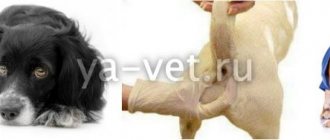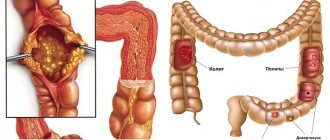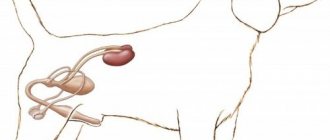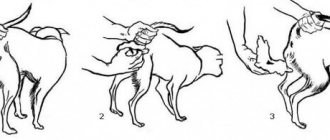Dogs, like other domestic and farm animals, are susceptible to various oral diseases. The peculiarity of this type of disease is that for a long time the owner may not notice the problem in the pet. In particular, this applies to aggressive dog breeds and older dogs. In this article we will talk in more detail about inflammation of the salivary glands, symptoms and treatment of this pathology. This disease does not occur as often as, for example, dental problems. However, this does not make it any less serious.
Etiology of the disease
Most often, problems with the salivary glands occur in young individuals, as well as in representatives of certain breeds: poodles, boxers, German shepherds, dachshunds. Malfunction of the salivary glands most often manifests itself in increased salivation. The dog begins to frequently swallow the disturbing liquid. The saliva produced may have an unpleasant odor.
The inflammatory process is quite intense. It can spread to neighboring areas and cause problems with the dog's swallowing and breathing. The animal experiences shortness of breath, even during periods of rest. In addition, constant irritation in the mouth and pharynx can cause the animal to vomit.
The inflamed glands increase in size. Sometimes pus can accumulate in them. Inflammation of the salivary glands in dogs is divided into two types: mumps, sialadenitis.
Prevention
As you know, any disease is easier to prevent than to cure, this applies to both humans and animals. Quite a lot has been said about the need for an annual preventive examination, but, nevertheless, not everyone listens to these recommendations. A preventive examination by a veterinarian-dentist significantly reduces the likelihood of inflammation of the salivary glands. As practice shows, cases of asymptomatic sialadenitis are rare, but still occur, and if, due to your own carelessness, you let everything take its course, you cannot avoid problems with your pet’s health.
Mumps is an inflammation of the parotid salivary gland. The causes of mumps in dogs can be trauma, penetrating wounds (from the external or internal environment) or systemic infection, for example, with rabies or canine distemper.
Clinical symptoms of mumps in dogs include fever, depression, tenderness and swelling of the salivary glands, and sometimes a lack of appetite. When an abscess forms, swelling can spread from the parotid gland to surrounding tissue, causing significant neck swelling and severe pain. When a systemic infection develops, the animal also experiences other clinical symptoms (depending on the type of infection), for example, neurological disorders.
Diagnostics includes:
- taking an anamnesis – determining the animal’s vaccination status to exclude systemic infections; determining the risks of injury (for example, if the animal often plays with wooden sticks), etc.;
- clinical examination of the animal - the presence of edema is usually noted in the area where the parotid glands are located - on one or both sides; significant pain;
- routine blood tests - leukocytosis may be observed - a sign of an inflammatory process; increase in nonspecific enzymes, such as LDH, AST, hyperglobulinemia;
- X-rays may be useful to exclude the presence of radiopaque foreign bodies, ultrasound of the neck - to differentiate lymphadenitis from inflammation of the salivary gland, determine the boundaries of the inflammatory process, and exclude the presence of cavities;
- if an abscess is suspected, the contents are aspirated and assessed macroscopically; in the presence of a dense formation, a cytological examination may be performed to confirm the diagnosis of mumps.
Treatment
Treatment of mumps in dogs includes first-line antibiotic therapy. When an abscess forms, it is often necessary to drain the cavity with possible removal of the foreign body and daily sanitation with antiseptic solutions.
With the development of systemic infections or involvement of the tissues surrounding the salivary gland in the inflammatory process, the prognosis may be unfavorable. That is why it is necessary to contact a veterinarian in a timely manner and determine the cause of mumps.
The article was prepared by doctors of the therapeutic department "MEDVET" © 2021 SEC "MEDVET"
Sialadenitis
Sialadenitis in dogs is usually called inflammation of the sublingual or submandibular gland. The cause of inflammation can be injuries, blockage of the salivary ducts by foreign bodies, past illnesses, etc. It manifests itself in the form of severe swelling of the affected area. If the sublingual area is damaged, the dog has difficulty moving its tongue. If the submandibular gland is damaged, the tumor can be felt in the intermaxillary space. Treatment will depend on the stage and complexity of the disease. If there is a purulent formation in the gland, the affected area must be opened and cleaned. In other cases, you can do without surgery.
How is the treatment performed?
How to alleviate your pet's condition? Before the doctor examines him, you can try giving the dog warm water or any analgesic. Remember that you cannot self-medicate, as this can be fatal for the dog.
The doctor must examine the animal, prescribe a comprehensive examination, collect tests and perform a biopsy. If necessary, some manipulations are performed under safe anesthesia. There are two ways to solve the problem:
Drug treatment and surgery. In especially severe cases, if tumors, cysts, or stones are identified that have blocked the salivary ducts, the doctor will consider surgery appropriate. The indication for surgery is a violation of the integrity of the gland when the secretion does not come out through the duct (this may be the result of a penetrating wound).
In this case, the gland is removed, the inflammatory foci are excised with an electrocoagulator, followed by the installation of active drains and antibiotic therapy for 7-10 days. The drainage is removed on day 3-4, and the sutures are removed after 7-10 days. These dates are approximate, since much depends on the severity of the disease, the age of the animal, breed, characteristics of the body, etc.
In most cases, the doctor does not see the need for surgical intervention; antibiotic therapy gives a good result, while taking vitamins, steroids and analgesics, the treatment outcome is favorable. But the dog owner must take the task at hand seriously; the animal must take the recommended medications in a timely manner.
A pet needs care, care and attention. Walking and exposure to cold air are completely excluded. For mumps, the doctor may recommend a warming alcohol compress, physiotherapeutic procedures: UHF or heating the inflamed area with a Minin lamp. Ichthyol ointment can also be useful; it will speed up the process of abscess formation; if necessary, the doctor should open it.
Mumps
Mumps is the most common type of inflammation. Mumps affects the parotid glands. The cause is usually viral and bacterial infections. This type of inflammation is characterized by swelling of the glands in the parotid areas. Fortunately, mumps is a simple inflammation. In most cases, considering mumps, symptoms and treatment of this disease, we see that they are in many ways similar to inflammation of other salivary glands.
Causes of the disease
Let's look at the main causes of inflammation of the salivary glands in dogs.
- Viral and bacterial infections. This is the most common cause of the disease. Especially often it provokes inflammation of the parotid glands (mumps).
- Injuries and wounds. Even the smallest injuries can cause problems. As a rule, the dog receives damage to the salivary glands while chewing hard food (dry food, bones, etc.), as well as during active games. Especially if it is on a chain or leash. There are a number of situations where the salivary glands can be injured during medical procedures.
- Foreign bodies in the salivary ducts. These could be leftover food, hard blades of grass that the dog likes to chew, etc.
- Neoplasms (tumors and cysts). This is more typical for adult dogs. As a rule, tumors and other neoplasms form under the mucous membranes. They cause severe swelling and inflammation of the salivary glands in dogs. Solving the problem requires surgical intervention.
- Some diseases previously suffered by the dog: secondary form of plague, pharyngitis, stomatitis, etc.
Reasons for development
The inflammatory process in the salivary glands of a dog can be caused by:
- Gland injuries;
- Penetration of pathogenic microorganisms into the gland tissue against the background of a decrease in the resistance (resistance) of the dog’s body;
- Spread of an infectious agent from other organs;
- Stones of the salivary ducts, formed when calcium metabolism or water-salt balance is disturbed in the dog’s body;
- Dental diseases (stomatitis, gingivitis, tooth root abscess);
- The presence of tartar blocking the salivary duct;
- Malignant or benign tumors of the salivary glands;
- Congenital or acquired anatomical abnormalities of the organ;
- Frequent hypothermia of the animal.
According to dog breeders, some dog breeds have a genetic predisposition to the development of this pathology. At risk are German shepherds, boxers, dachshunds, poodles and greyhounds. As for the types of disease, sialadenitis is more often observed in young animals, and mumps in dogs over 6 years of age.
Symptoms of the disease
In order to promptly detect inflammation of the salivary glands in a dog, it is necessary to carefully observe the pet’s behavior. Let's take a closer look at the symptoms that should alert a dog owner.
- Excessive salivation in dogs. The amount of saliva during illness increases several times. The dog often begins to swallow excess. Sometimes the animal cannot cope with the amount of fluid secreted, and it flows profusely from the mouth. When there is pus in the inflamed gland, the discharge acquires a specific unpleasant odor.
- The appearance of shortness of breath. Excessive saliva secretion irritates the dog's throat. This process provokes severe shortness of breath even while the animal is at rest. This process can also provoke a gag reflex.
- This type of inflammation can also spread to the soft tissue of neighboring areas. This makes swallowing difficult and causes pain. Because of the pain, the dog does not eat or drink anything.
- Increased body temperature. As with any other type of inflammation, the dog’s body temperature rises. Mild fever is possible.
- Long-term refusal of food leads to dehydration of the animal and severe weight loss. Against this background, nervous disorders may also appear and aggressive behavior may increase.
Diagnosis of the disease
Any inflammation of the salivary glands in dogs requires a thorough diagnosis. This is necessary not only to select the correct treatment, but also to exclude the presence of malignant tumors in the mouth. During diagnosis, the doctor must collect all the information about the animal: past illnesses, medical procedures performed, the animal’s love of eating grass and garbage, etc.
Since during the examination the animal experiences pain and often behaves aggressively, safe anesthesia is used. This gives the doctor the opportunity not only to conduct a thorough examination, but also to easily collect all the necessary tests.
Diagnostic methods
If you suspect mumps, your pet should be seen by a veterinarian. After a clinical examination, a biopsy will be taken from the animal and a general clinical blood test will be performed. Based on the results of the biopsy, the veterinarian will be able to exclude a neoplastic cause of the pathology and determine the causative agent if the disease is infectious.
An informative diagnostic method is an x-ray examination of the dog’s skull in two projections. X-ray will help detect a neoplasm, blockage of the lumen of the gland with mineral formations, an anomaly in the development of the organ.
Medical assistance
Treatment of any inflammation of the salivary glands in dogs is prescribed only after the doctor has the results of all tests. Therapy can be medicinal and surgical. Drug treatment includes taking antibiotics (the course lasts for 10–14 days), as well as the use of painkillers. In some cases, steroid medications work well. This group of medications most often raises questions among animal owners. In particular, the use of the drug Prednisolone is causing concern. Let's figure out what Prednisolone is and what it helps with. This is an anti-inflammatory drug. It is used in case of detection of nonspecific inflammation and for some complications. It helps to quickly reduce the size of the tumor and the inflammatory process. Thus, having figured out what “Prednisolone” is and what it helps with, we see that you should not be afraid to give this drug to your pet.
Also, in case of an abscess, it is necessary to regularly apply anti-inflammatory ointments (Vishnevsky ointment)
Surgical intervention is prescribed in cases where the cause of inflammation is neoplasms (tumors, cysts, etc.), abnormalities in the anatomical structure of the mouth or gland, the formation of stones, or penetrating wounds of the salivary gland. The operation is performed under general anesthesia. After the intervention, a course of antibiotics is prescribed.
Causes of inflammation of the salivary glands in dogs
In dogs, according to their anatomical location, the parotid, submandibular, sublingual and zygomatic glands are distinguished. All these paired organs can be subject to mechanical or biological effects. In veterinary practice, it is generally accepted that the following reasons lead to inflammatory processes in the salivary glands of a pet:
- Injuries, including microtraumas of the glandular tissue of the organ.
- Dental diseases. The presence of a tooth root abscess, stomatitis, gingivitis, or tartar in a dog often leads to inflammation of nearby tissues and organs.
- Anomalies, including congenital ones, in the structure of the salivary glands.
- Inflammatory processes in other organs can lead to the spread of the infectious agent into the glandular tissues, including causing mumps in dogs.
- If there is a metabolic disorder, stones can form in the ducts of the paired organ. By damaging the mucous membrane, foreign objects also contribute to blocking the lumen of the canal, leading to sialadenitis.
- Neoplastic processes, as a result of which neoplasms develop in the salivary glands, are a common cause of their inflammation in elderly pets.
- Penetration of pathogenic viruses, bacteria and fungi into organ tissue.
Salivary glands in dogs
According to experienced dog breeders and veterinary specialists, the cause of the development of pathology is often regular hypothermia of the body, a decrease in resistance due to concomitant diseases. Many breeders note a genetic predisposition of some breeds to mumps. Thus, inflammatory damage to the salivary glands is often observed in German shepherds and boxers. Dachshunds, poodles and greyhounds often suffer from sialadenitis.
The tendency to develop mumps of neoplastic etiology is typical in most cases for older pets. Non-infectious sialadenitis is observed, as a rule, in young animals. In some cases, the pathology develops against the background of previous infectious diseases - pharyngitis, canine distemper.
And here is more information about the treatment of boils in dogs.
Disease prevention
Like any disease, inflammation of the salivary glands in dogs is easier to prevent than to treat. In order to keep your pet safe, the following rules must be followed:
- Try to avoid head injuries.
- Have your mouth examined regularly to prevent the formation of tartar.
- It is good to treat any inflammatory processes in a dog.
And in conclusion of this article, we remind you that we are responsible for our pets. And their health directly depends on our attention and care.
Animal care
The dog needs to be provided with complete rest, surrounded with care and attention, this will speed up the healing process and lift the animal’s spirits. It is necessary to reconsider the composition of the daily menu. Swallowing food should not cause difficulty, so dry food should be completely excluded from the diet for a while. Offer your pet broth, finely chopped meat, and milk.
Very often, dog owners ignore the recommendations of specialists, and, having noticed dangerous symptoms, do not rush to see a veterinarian. In addition, it may seem that the dog has recovered on its own; this most often happens with young animals. This course of events should not be a reason for refusing to go to the doctor.
Unfortunately, you may waste time and allow the disease to progress. In most cases, cystic degeneration begins, this most often happens with the submandibular and sublingual glands. Other, no less dangerous complications may also occur.
If sialadenitis is not treated in a timely manner, necrosis or necrosis of the salivary gland tissue occurs, which can lead to irreversible consequences. This is why it is so important to seek help from a specialist in a timely manner. Remember, we are responsible for those we have tamed, so we must constantly take care of their health and safety.











